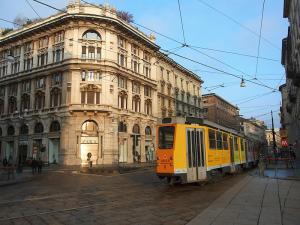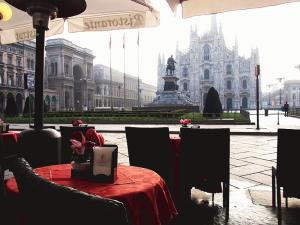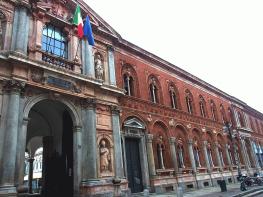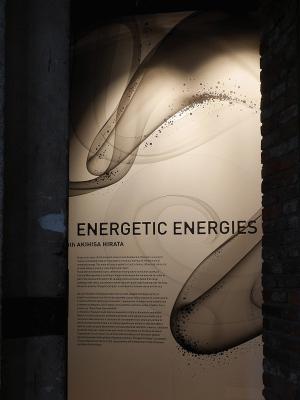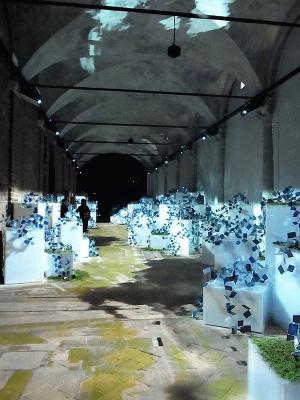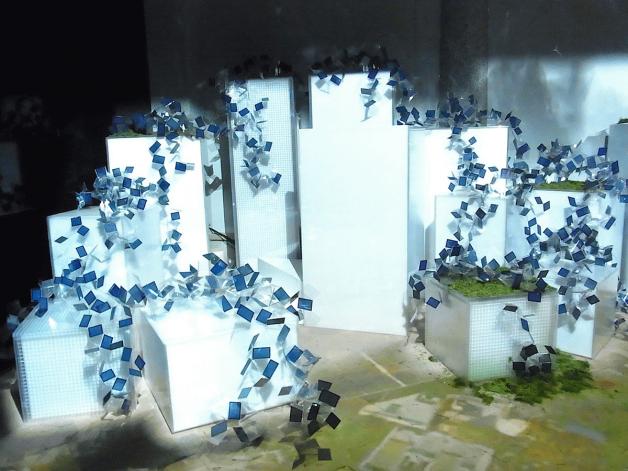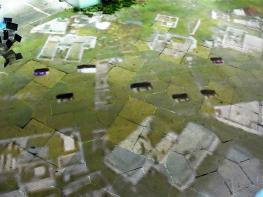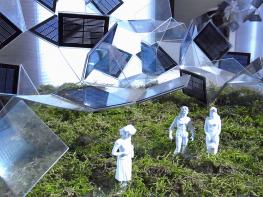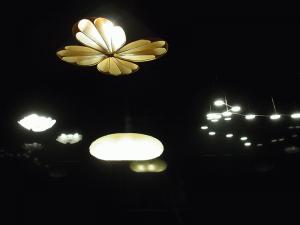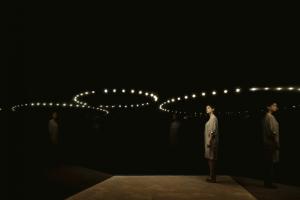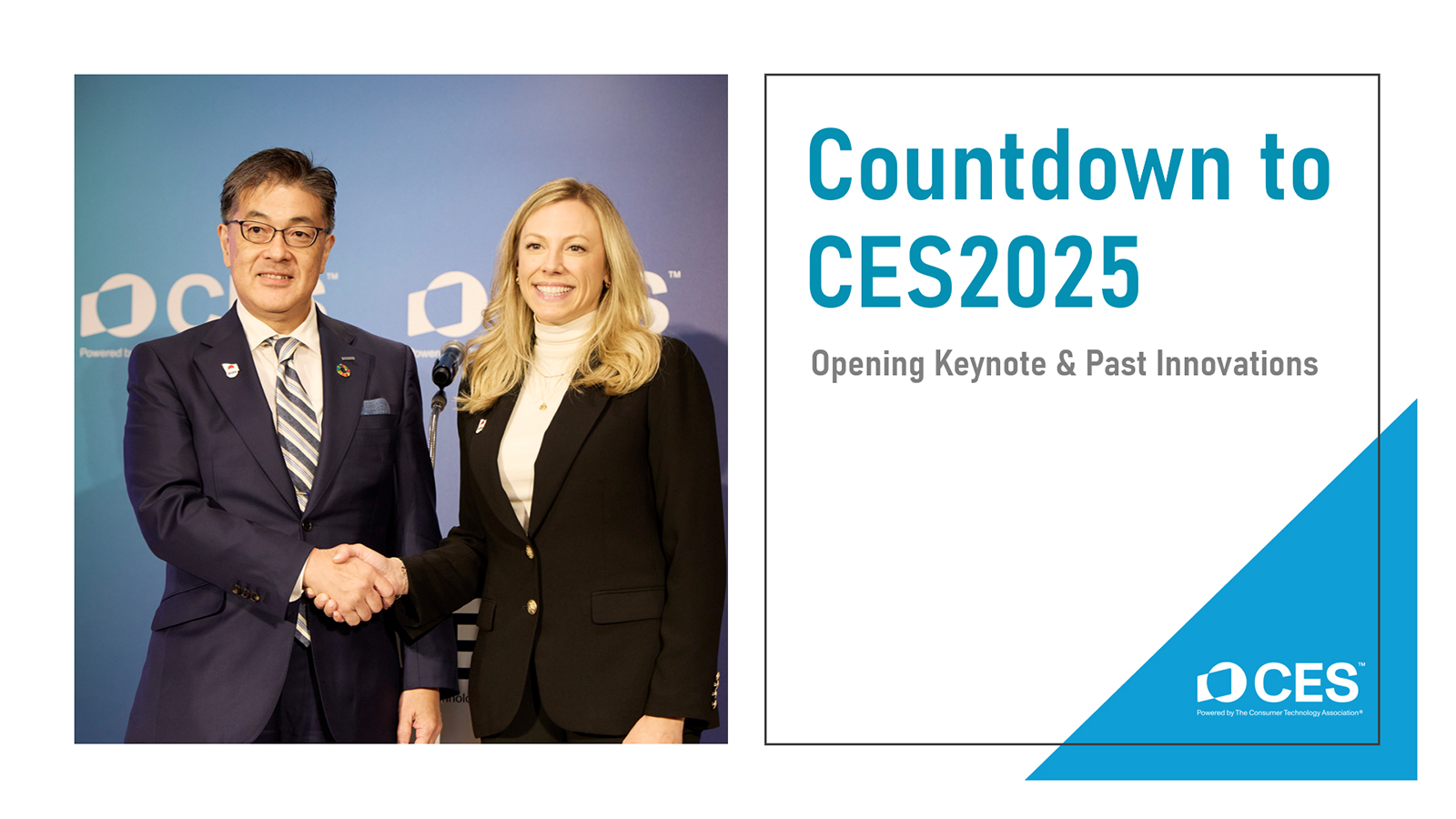- Colorful trams run through central Milan
- Duomo Square, at the heart of Milan. Flowers on the tables announce the arrival of spring
A futuristic space at the stately University of Milan
-
University of Milan, where the presentations are held
Built by Duke of Milan Francesco Sforza in the mid 15th century, the grand brick-buildings of the University of Milan are some of the most treasured architectural structures in the city. Panasonic's presentations are set in the campus's Portico Richini galleria, which is cosponsored by Interni Magazine and the city of Milan. The gallery is famous for hosting quality exhibits that draw large crowds.
Curious to see how Panasonic's presentations would embody this year's Salone theme, "Hybrid Architecture & Design," I head for the university. After passing through a unique redbrick entrance, I come upon a luxurious, white-plastered galleria at the end of the hallway with the words "Energetic Energies" printed on a modern-looking panel. This panel marks the entrance to the main Panasonic presentation.
Upon stepping through black curtains, I find myself standing in a comfortable white and green space with soft lighting, moving shadows and soothing background music. Numerous white rectangular objects representing miniature high-rise buildings in hilly terrain are covered with countless tiny solar modules that are scattered like leaves on plants. When viewed from afar, they look vibrantly alive and contribute to a relaxing environment that fuses past, present, city and nature. Even though the presentation represents a futuristic city, it feels completely natural within a historic Renaissance-era building.
- The entrance to Panasonic's presentation
- Panasonic's "Energetic Energies" presentation
More than visually appealing, the presentation provides a glimpse of the future
Individually, the 6,000 or so 1/20-scale solar modules look manufactured and lifeless. But when viewed in relation to the entire exhibition space, they contribute to a comfortable environment. This is largely due to their three-dimensional placement (by presentation architect, Akihisa Hirata), which is reminiscent of leaves on plants and embodies Panasonic's "Energetic Energies" design concept. By presenting conventional two-dimensional solar panels in a three-dimensional context, Mr. Hirata provides a glimpse of a future where energy production coexists more harmoniously with nature. (For more details on the presentation's design concept, please refer to Vol. 1 "Solar panels shaping the look of cities and energy resources in the future.")
- Solar panels are placed three-dimensionally like leaves on plants
Immersed in the comforting space, I remember what I learned at a winery in Tuscany. Grapevines in that world-famous wine-producing region are planted north-to-south so they receive maximum sunlight as the sun moves east to west. In this presentation, the solar panels are placed at various angles like leaves on trees, instead of lying flat, to absorb more sunlight. I had always imagined a future where technology reigned supreme, but now I could see there was room for future cities to borrow from nature.
Sound effects contribute to the sense that this is more than just a presentation. It's a glimpse of the future. Listening closely, I can hear laughter, children's voices, railway crossing warnings and other sounds representing the hustle and bustle of a city being played at low volume together with soothingly sublime a cappella music. These sounds blend naturally with city sounds coming from the street outside the venue and remind me that the future being presented in this presentation is an extension of our daily lives. Visitors like myself can experience more than a presentation. We can experience the future.
A story told with shifting reflections and floating clouds
-
Various moving objects are projected onto the floor
Images projected onto the buildings and solar panels add movement and a sense of energy to the presentation. The countless images from 17 projectors include cars and trains that convey urban vitality by moving continuously around the floor. They also include slow-moving cloud shadows from above my head that draw me into the illusion that I am standing between the sky and the city. These various projections constantly affect the colors and reflections on the buildings and solar panels, bringing the whole city to life.
-
Figurines help convey the presentation's message
"See, there are people there," an Italian gentleman standing next to me says while pointing at miniature figures on one of the buildings. "There are stories there, too. The city and the people have their own stories. This is not an exhibition. It's a vision of the future," he adds. While Italy is known for its sunny weather, it continues to be plagued by energy shortages and I am curious to hear what this local citizen thinks about the solar panel presentation. "First of all, the idea itself is wonderful," he replies to my query. "It's sophisticated, and the atmosphere of the venue is fantastic. It seems to propose a future where technology is used in a natural way." Listening to his comment, I wonder if we will one day see three-dimensional solar panel installations on the hills of Tuscany.
Having walked through the main presentation area, I now come to a presentation of life-sized solar panels and energy storage battery systems. They give me a realistic sense of just how large the depicted city in the main presentation would be. I walk on, overwhelmed by the dramatic new image in my head.
- Life-sized solar panels help visitors grasp the depicted city's scale
Firsthand experience with cutting-edge LED technology and design
I then arrive in a softly lit area displaying advanced LED technology in fixtures designed by young Milan designers. This is the Panasonic presentation for products related to generating, storing and saving energy.
LED lighting is becoming popular and well-known in Italy, but I have personally heard many Italians question its use at home because they dissaprove of its strong white light. The products in this presentation are emitting soft yellowish light and can be adjusted in intensity. Made possible by proprietary Variable-Colour LED Lighting technology, they generate white light when bright and yellowish light when dim. Young Milan designers made the most of this technology by creating four stylish chandeliers appropriate for both modern and classic interiors.
- LED fixtures developed in collaboration with Milan designers
- Panasonic's Nostalgic Clear LED bulbs are reminiscent of incandescent bulbs
photo by Satoshi Shigeta
I personally tend to avoid products that scream "modern design." But these chandeliers give me a satisfying feeling of warmth. Some are made of felt and others remind me of flowers. I end up spending more time here than I expected, examining every little detail of the chandeliers because I want them for the lounge in my home. Clearly, energy-saving technologies are progressing and it won't be long before our homes, and every aspect of our lives, are supported by such advanced, stylishly designed technologies.
(Reported by Asami)
Related Links:



